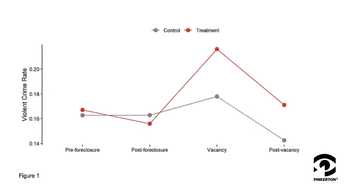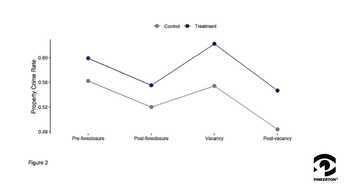This blog is a part of our new series, "Perspectives in Crime." We'll be exploring leading academic studies that touch on crime data.
A spate of fires in vacant buildings across the country over the last several years newly emphasizes the relationship between vacant and abandoned buildings and local area crime risk.
Research has demonstrated that abandoned buildings and urban blight bare large hidden costs in terms of crime risk, their draw on local public safety resources, and their contribution to negative health outcomes for elderly and at-risk community members. A study by Sammy Zahran, Terrence Iverson, et al. published in Ecological Economics reported that in 2011 the Detroit Fire Department responded to more than 9,000 structural fires, approximately 85% occurring in vacant buildings.
The Relationship Between Foreclosures and Crime Rates
Residential foreclosures and vacancies negatively impact both displaced families and the surrounding neighborhood. Research by Professors Lin Cui and Randall Walsh published in the Journal of Urban Economics analyzes how foreclosures and related vacancies foster violent crime at the neighborhood level, and how this effect worsens with prolonged vacancy. Cui and Walsh observe a similar effect with respect to property crime, but the statistical signal is weaker.
While prior scholarship, including social disorganization theory and broken windows theory, has long understood how blighted, neglected, and abandoned properties encourage crime, Cui and Walsh sought to understand the causal mechanism involved. Their study focused on Pittsburgh, Pennsylvania from 2006-2009, and tracked both foreclosure records and whether foreclosed properties became vacant. They combined foreclosure and vacancy data with detailed geospatial crime data to observe how the risk of crime changed around a property as it passed through the foreclosure process.
Going beyond "broken windows" theory
This study was set against the backdrop of the mortgage crisis that induced the Great Recession. At the end of the study period, in the third quarter of 2009, residential mortgage delinquency rates were at 9.64 percent according to the Mortgage Bankers Association, the highest level achieved since 1972. During the subprime mortgage crisis, the foreclosure rate in the United States of America jumped from 0.58% in 2006 up to 2.23% in 2009.
In Pennsylvania, foreclosed properties become vacant after a multistage process involving efforts to sell the property. If the property fails to sell, it becomes a Real Estate Owned property (REO) and is likely to go vacant. Researchers used the REO status of a property to determine vacancy and used data on gas service shut off dates to determine how long a property stood vacant. Over the study period, 3,282 properties were foreclosed in Pittsburgh and 1,403 of them became vacant.
Where many prior studies analyzed foreclosure and/or vacancy impact on crime rates at higher levels of aggregation, Cui and Walsh’s geographically precise crime data enabled them to analyze crime within 250 feet (Treatment Area) versus 250-350 feet (Control Area) of a foreclosed or vacant property. Because other conditions that produce crime are identical at <250 feet versus 250-350 feet of a foreclosed or vacant property, the researchers could statistically isolate crimes attributable to the foreclosure process.
How foreclosures affect neighborhood safety and crime rates
Cui and Walsh discovered that crime increased slightly as a property entered the foreclosure process and increased substantially as the property became vacant. Analyses showed that, on average, violent crimes within 250 feet of foreclosed homes (Treatment Area) increases by roughly 19% upon vacancy, as compared to crime in areas 250 and 350 feet away (Control Area).
Figures 1 and 2 show quarterly crime rates for violent and property crime through all four stages of the foreclosure process, with one line representing crime rates within the proximate orbit of <250 feet of a foreclosed property and a second line representing crime in the surrounding control area of 250-350 feet. The surge is more pronounced in the area nearest to the vacant property.


The Impact of Vacant Buildings on local public safety and crime
Additionally, Cui and Walsh show that the impact of vacancy on crime increases with the time length of the vacancy, peaking at approximately 12-18 months after a property become vacant. Intriguingly, and in support of the vacancy mechanism, the risk of crime subsides when a property is reoccupied. Figure 3 shows the relationship between vacancy duration and the relative difference in the violent crime rate in areas near (<250 feet) versus areas more distant (250-350 feet) of a vacant property.

An important mechanism involved in the relationship between crime and vacancy is that a vacant property signals the absence of guardianship. Research shows that vacant, abandoned, and blighted properties invite crime and delinquency, especially acts of arson (Zahran et al., 2019). The U.S. Fire Administration encourages the securing and boarding up of vacant and abandoned properties to reduce arson risk, steps many communities are taking after noteworthy increases in fires involving derelict properties.
Cui and Walsh’s research builds on prior evidence of how housing abandonment can hasten the decline of a neighborhood, setting in motion a negative spiral toward violence.
Curious about crime risk in your area? Check out Pinkerton Crime Index to learn more.
Sources
Cui, L. & Walsh, R. (2015). Foreclosure, Vacancy and Crime, Journal of Urban Economics, 87:72-84.
Reducing arson at vacant and abandoned buildings. U.S. Fire Administration. (n.d.). https://www.usfa.fema.gov/prevention/arson/vacant-abandoned-buildings/
Zahran, S., Iverson, T., McElmurry, SP., Weiler, S., Levitt, R. (2019). Hidden Costs of Blight and Arson in Detroit: Evidence from a Natural Experiment in Devil’s Night. Ecological Economics. 157: 266-277.





